Work, energy and power
Definition of work
In physics, work is done by forces. If a force acting on an object displaced the object, then it is said that a work is done on the object by the force. So, for a work to be done by a force, the force should displace the object.In the figure below, an object is pulled by a rope with a force $\vec F$. The object has moved with a displacement of $\vec d$. How much is the work done on the object by the force?
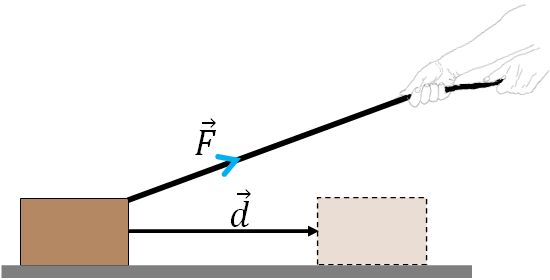
Work done by a constant force, $\vec F$ is defined as
$W=Fd\cos\theta$
where $F$ and $d$ are the magnitudes of the force and the object's displacement respectively, and $\theta$ is the angle between the force and the displacement.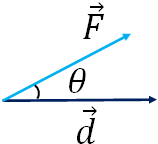
Note that the above equation is valid for any constant force. Constant force means, both the direction and the magnitude of the force do not change during the object's displacement.
If there is no displacement of the object, $d=0$, and the work, $W=0$.
When the force and the displacement are perpendicular to each other, θ = 90°, and the work is
$W=Fd \cos 90=0$
So, when the force is acting on the object in one direction and the object is moving in a direction perpendicular to the force, then there will be no work is done by the force. For example, if you walk on a horizontal surface, the force of gravity does no work on you as it acts perpendicular to your displacement.
SI Unit of work:
SI unit of work is joule $(J)$, it is same as $N.m$.Work done by gravity and work against gravity
If you drop an object, the object makes a displacement vertically downward due to the force of gravity. Here, the object's displacement and the force (the force of gravity) are in the same direction. So, θ = 0. If the object makes a downward displacement, $h$, then the work done on the object by gravity is$W=F_g h\:\cos0=mgh$.
But when you lift an object, the gravity does a negative work on the object as the object moves opposite to the force of gravity.
If you raise an object by attaching a rope with it, then the lifting force is the force of tension on the rope. You can also place an object on your hand and lift it by raising your hand, here the force that raises the object is the normal force on the object by your hand. While the gravity does a negative work on the object, the lifting force does a positive work on the object as the lifting force and the object's displacement are in the same direction.
How much work is required to lift an object without acceleration?
Let us consider an object that is being raised by a rope. The force that raises the object is the force of tension on the rope, $F_t$.

There are two forces acting on the object, $F_t$ in the upward direction and the force of gravity in the downward direction. When the object is lifted with a constant velocity, then the acceleration of the object is zero. And the force of tension balances the force of gravity,
$F_t=mg$
So, the work by $F_t$ is
$W=F_t h \cos 0=mgh$
This is the work required to lift an object to a height $h$.
Work done when you climb stairs or a ramp
When you climb stairs, you are doing a work against gravity. Who is doing that work? the stairs ? no. It is done by your body muscles. While walking on the stairs, you (muscles) are lifting your body against gravity. When you walk with a constant speed, the lifting force balances the force of gravity. So, the work done by you when you climb stairs is$W=mgh$
where $h$ is the height of the stairs.
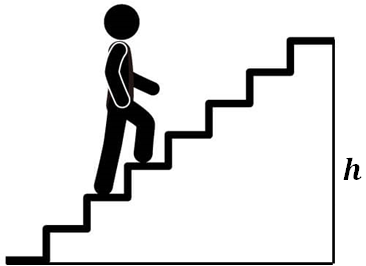
Note that, whether it is the work by gravity, work against gravity or the work required to climb a staircase or a ramp depends only on the height. For example, if you make a displacement on a ramp, you have two components of displacements as displacement is a vector: a vertical and a horizontal displacement. Work for the horizontal displacement is zero, as the force and this displacement are perpendicular to each other. So the work depends only on the vertical displacement, which is the height. The length of the ramp does not affect the work.
Work by friction
If an object moves on a non-smooth surface, then the friction by the surface acts in the opposite direction to the direction of motion of the object. Let us consider, an object is moving on a surface in a straight line. The object makes a displacement, $\vec d$.
$W=F_{fr} d \cos180=-F_{fr}d$
$F_{fr}$ and $d$ are positive as they are the magnitudes of the friction force and the object's displacement. So, the work by friction is always negative.
Now let us consider, the object is moving on a path as shown below.
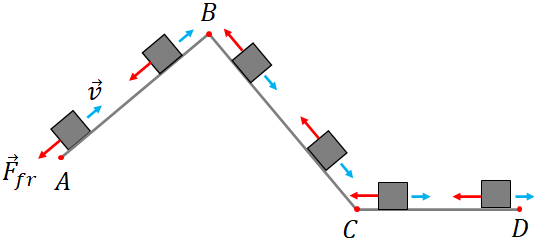
Here, the path is not a straight line instead there are three straight paths: AB, BC and CD. The initial and the final positions of the object are A and D. So, the displacement of the object is AD. Now, if you look at the direction of the friction force, it is not in one direction but is different for different paths. That is the force is not constant, and we cannot use the displacement AD to find the work. But you see that, in each straight path, the force is constant because at any point on the path, the direction of the force is the same. So, we can find the work in each straight path. Then if you add the work in each segment, we get the total work by friction.
Finding the work in each straight path and add them, we get
$W=-F_{fr}\, AB-F_{fr}\, BC-F_{fr}\, CD$
$=-F_{fr}(AB+BC+CD)$
From the figure, you see that $AB+BC+CD$ is the total distance traveled by the object. So, we can write
$W=-F_{fr} d$, where $d$ is the distance traveled by the object.
Note that in the work by friction equation, $d$ is the distance, not the magnitude of the displacement. The above equation is valid for any path, which includes curved paths.
Energy
Energy is the ability to do work. If an object has an ability to do some work, then we say that it possess an energy. There are different forms of energy, such as potential energy, kinetic energy, thermal energy, electrical energy and radiant energy. Kinetic and potential energy are called mechanical energy.Kinetic energy
When an object is in motion, it has an energy called kinetic energy.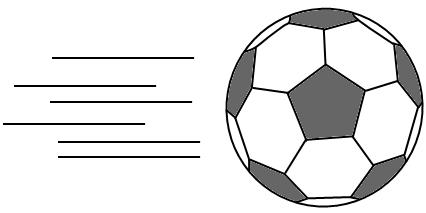
$KE=\dfrac{1}{2}mv^2$
Work-Energy Principle
When a work is done on an object, the kinetic energy of the object changes. We can show that "the net work done on an object is equal to the change in kinetic energy of the object",$W_{net}=\Delta KE$.
This is called work-energy principle or work-energy theorem. The derivation of this equation is given in a separate page, derivation-of-work-energy-principle.
Potential energy
If you lift an object to some height, it acquires an ability to do some work. This is because, if you release the object, its speed increases and so the kinetic energy of the object changes. The change in kinetic energy results from the work being done on the object according to the work-energy principle. The ability to do this work was acquired by the object due to its position as it was raised from the ground. Also, if a spring is stretched or compressed, it gains an ability to do work that you can see by releasing the spring. An object has an ability to do work means, it has an energy. The energy an object possess because of its position or state is called potential energy.Gravitational potential energy
You have learned that, to lift an object to some height, a work needs to be done on the object. The work that was done is not wasted instead it is stored as the potential energy of the object. The potential energy is exactly same as the work done on the object to raise it. We call this potential energy of a lifted object as the gravitational potential energy.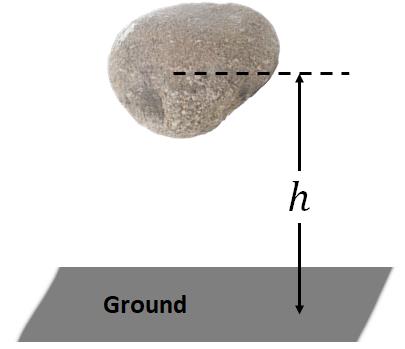
$PE_g=mgh$.
where $m$ is the mass of the object.Elastic or spring potential energy
To stretch or compress an elastic spring, a force needs to be applied on the spring.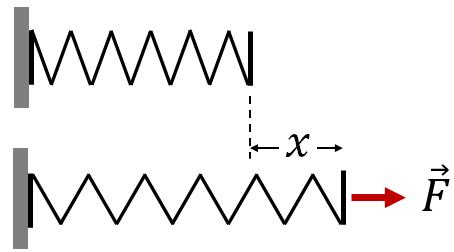
$F=kx$, where $k$ is the spring constant or force constant of the spring.
This force does a work on the spring. The work done to stretch or compress the spring is
$W=\dfrac{1}{2}kx^2$
Due to this work, the spring gains some energy, and that energy is called, spring potential energy or elastic potential energy.Therefore, elastic potential energy of a spring is
$PE_{spring}=\dfrac{1}{2}kx^2$.
Total mechanical energy
Potential and kinetic energies are called mechanical energy. If you add the potential and the kinetic energy of an object, you will get the total mechanical energy of the object.$Total \:Mechanical \: energy = PE + KE$
Conservative and nonconservative forces
You saw that the work done by gravity depends only on the vertical displacement of the object. This means, the work by gravity is independent of the path but it depends only on the starting and the end position of the object. If the work done by a force is independent of the path of the object, then the force is called, a conservative force. Therefore, gravity is a conservative force. Another example of conservative force is the force applied to stretch or compress a spring.But if a work by a force depends on the path of the object, then that force is called a nonconservative force. Since the work by friction depends on the path, friction is a nonconservative force.
Work and potential energy with conservative force
We can show that the work done by a conservative force is$W_c=-\Delta PE$
We can prove this by considering the work by gravity as force of gravity is a conservative force. Assume an object is at some height $y_1$. Now, you are lifting this object vertically upwards to a new vertical position, $y_2$. So, the vertical displacement of the object is
$h=y_2-y_1$
Finding the work by gravity,
$W=-mgh=-mg(y_2-y_1)$
$=-(mg\,y_2-mg\,y_1)$
$mg\,y_1$ is the initial gravitational potential energy and $mg\,y_2$ is the final gravitational potential energy of the object. Therefore,
$W=-\Delta PE_G$
This equation is true for gravitational potential energy as well as spring potential energy. That is, it is valid for any work that is done by a conservative force. So, we can write$W_c=-\Delta PE$
Total work on an object or a system of objects
An object can have both conservative and non-conservative forces acting on. So, when calculating the work on an object, we need to consider the work by both. Net work on an object is therefore, sum of the work by conservative forces and that by nonconservative forces:$W_{net}=W_c+W_{nc}$
We have from work-energy theorem,
$W_{net}=\Delta KE$
And also we have
$W_c=-\Delta PE$
Substituting these in the net work equation,
$\Delta KE=-\Delta PE+W_{nc}$.
or$\Delta (KE+PE)=W_{nc}$.
or$\Delta E=W_{nc}$.
where $E=KE+PE$, is the total mechanical energy of the system.
Law of conservation of mechanical energy
When there is no non-conservative force (such as friction) acting on a system, $W_{nc}=0$, and we have$\Delta E=0$.
or$E_{final}-E_{initial}=0$
where $E_{initial}$ and $E_{final}$ are the initial and final mechanical energies of the object or the system (if there is more than one object). From the equation we can write,$E_{initial}=E_{final}$
Thus the total mechanical energy of the system is constant., i.e., initial mechanical energy is same as the final mechanical energy. So there is no loss in mechanical energy when there is no nonconservative force acting on the system. We call this, the law of conservation of mechanical energy.Law of conservation of energy
You saw that the mechanical energy of a system is conserved when there is no nonconservative force is acting on the system. If there is a nonconservative force acting on the system, then we have this equation from before,$\Delta E = W_{nc}$
If friction is the only nonconservative force acting on the system, then
$W_{nc}=W_{fr}$
We have the Work by friction that is
$W_{fr}=-F_{fr}d$, where $d $ is the distance traveled by the object under friction.
When friction does work on an object, heat is generated. Heat is a form of energy, so we call the generated heat thermal energy. The amount of thermal energy generated by friction is $F_{fr}d$.
Substituting $W_{nc}=W_{fr}=-F_{fr}d$ in the first equation, we get
$\Delta E = -F_{fr}d$
or$E_{final}-E_{initial}=-F_{fr}d$
or
$E_{initial}=E_{final}+F_{fr}d$
On the left hand side of the equation, we have the initial mechanical energy, which is the total initial energy of the system. On the right hand side, the second term $F_{fr}d$, is the thermal energy. So, the part of the initial energy has now been transformed into thermal energy and the final mechanical energy is now lower than the initial mechanical energy. So, there is a transformation of energy but nothing is lost. That is the total energy is always conserved. This is called the law of conservation of energy, an important law of physics.
Power
Power is the rate at which work is done. If a work, W is done in a time, t, then the power, P is$P=\dfrac{W}{t}$
Since, when work is done, energy is transformed, power is also the rate at which energy is transformed,i.e.,
$P=\dfrac{E}{t}$
where $E$ is the amount of energy transformed in a time interval, $t$.
SI Unit of power is watt (W) that is same as J/s.
If you look at the electric bulbs or other electric equipments, you can see its power rating. A 100 W bulb uses 100 J of energy in 1s. Electric utility services charge us for how much energy was used by our electric equipments.
If the work is done by a constant force, then
$P=\dfrac{Fd \cos\theta}{t}$
$ =F\,v \cos\theta$
where, $v=d/t$ is the magnitude of the object's velocity. If the object moves in the direction of the force, then $\theta =0$ and we have
$P=F\,v$
Horse power
There is another common unit of power that is horse power (hp). This is not an SI unit, but it is used when mentioning the power of electric motors. The unit of hp for power was first adapted by James Watt, a Scottish engineer in the 18th century. It is just the average power of a horse, i.e., the average work a horse can do per second.The conversion factor from horse power to watt is
$1\,hp=746\,W$.
